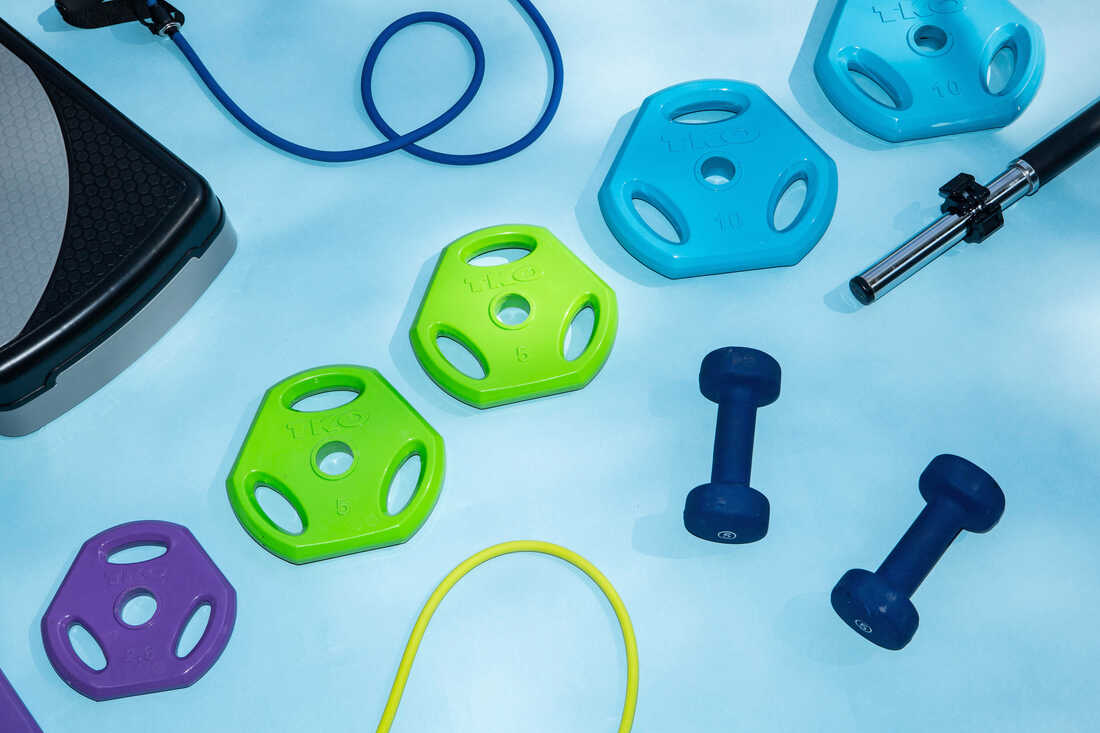
Photo Illustration by Becky Harlan/NPR

Photo Illustration by Becky Harlan/NPR
Strength training is a great way to exercise efficiently while preventing injury. But it can be intimidating to venture into the strength area of your gym if you don’t know what you’re doing. What if I do it wrong? What if everyone laughs at me? What if I hurt myself?
Gyms can feel particularly inhospitable if your body doesn’t fit the super gendered (and unrealistic) norms of what an “athletic” body looks like. A 2019 Penn State study found that women were significantly less likely to participate in strength-building activities than their male peers.

It turns out that getting into strength training isn’t actually that difficult, but it does take careful planning and willpower to fight against the ingrained social messages about who strength training is for — and who it isn’t for. We asked experts for their tips on getting started, and this is what they had to say:
Start by reestablishing your exercise goals
“The narrative that we have around strength, or rather fitness, is that fitness and weight loss are one and the same thing,” says Poorna Bell. Bell is a powerlifter and author of Stronger: Changing Everything I Knew About Women’s Strength. She started strength training after her husband died unexpectedly in 2016. She felt lost and weak, and she started working out with a personal trainer to help build strength, both physically and mentally.
If you can connect with other reasons for exercise — getting stronger, mental health benefits, joining a new community — it can help you to start from a more positive place. Bell recommends tackling this shift by reframing any exercise you do as work you’re doing with and for your body — to build strength, to achieve goals, to help your mental health — instead of work that you’re doing to carve your body into the ideal shape, size or weight.
Find the right support system for you
This starts with defining what you need — whether that’s a community of people who have similar goals, a routine tailored to your needs or equipment that you can actually lift. This will look different for you depending on where you live, how much money you feel comfortable spending and what you prefer. Maybe you want to work out with a personal trainer or take classes. Maybe you just want to follow some workouts on Instagram or YouTube!

Justice Roe Williams is the founder and executive director of Fitness 4 All Bodies, an organization that pairs activist work with fitness. He said it’s possible to tell pretty quickly whether a trainer, class, or gym community will align with your goals and ideals: “I always say if coaches are pushing their perspective around diet culture or weight loss, that is, in general, not a coach you want to go to.”
Remember that you can take the lead in your relationship. You can ask trainers not to frame your progress around your weight or BMI, and if you have specific training goals, share them!
Make a plan and start small

Photo Illustration by Becky Harlan/NPR

Photo Illustration by Becky Harlan/NPR
There are lots of beginner strength training plans available online! Casey Johnston, the writer behind She’s A Beast, recommends following a training plan that will encourage you to lift heavier weights incrementally.
“A beginning strength training program can be like three movements, three days a week, sets of five, and that’s it, she says. “Three movements and you’re done.”
Johnston recommends StrongLifts beginners programs, Barbell Medicine and the r/fitness subreddit as good places for beginners to start.

Get familiar with compound movements
The reason beginner plans use so few movements is because they’re often made up of compound movements, which are efficient exercises that use your muscles together the way they’re meant to be used. For example: During an arm workout, you could work your way through the bicep machine, the tricep machine, the shoulder press machine, and lateral raises or you could do a bench press and lat pulldowns, both of which use all your arm muscles together.
Finally, remember that you’re already really strong!

Photo Illustration by Becky Harlan/NPR

Photo Illustration by Becky Harlan/NPR
As we talked to these experts, the thing that kept coming up over and over as a barrier to people getting started in strength training was fear — fear that they’d hurt themselves, fear that people would judge them, fear that they’d look stupid.
“Fitness or bodybuilding is not any [more] special than taking a walk. It’s a process that we all build up to,” Roe Williams said. “To even navigate in a world where we are finding love for ourselves, that’s revolution. That’s strength.”

When you reclaim your relationship with your body and start working with it instead of against it, you’re working toward healing a lifetime of believing that you’re fundamentally bad and need to be fixed or improved in some way.
Of course, strength training is no replacement for therapy and medication if you’re really struggling with your mental health, but if you’re on a journey of healing your mind in some way, working with your body can and should be part of that process, too.
Poorna said that strength training “has proved to me many times in the past that I am stronger mentally and physically than I ever give myself credit for. And that is something I’m never going to not need.”
The audio portion of this episode was produced by Janet W. Lee, with engineering support from Neil Tevault.
We’d love to hear from you. If you have a good life hack, leave us a voicemail at 202-216-9823, or email us at [email protected]. Your tip could appear in an upcoming episode.
If you love Life Kit and want more, subscribe to our newsletter.
